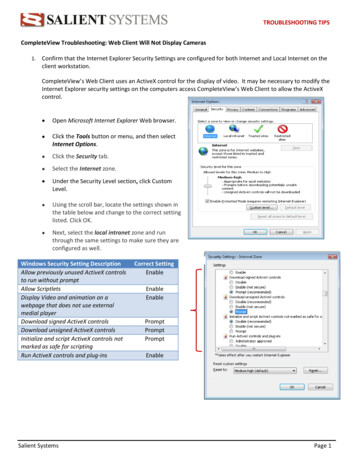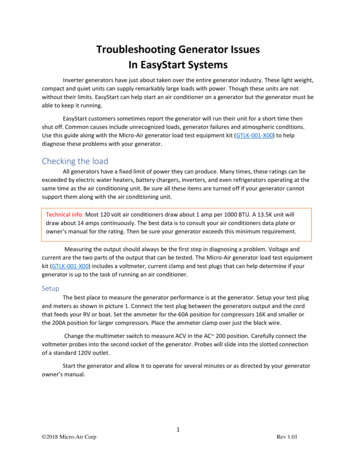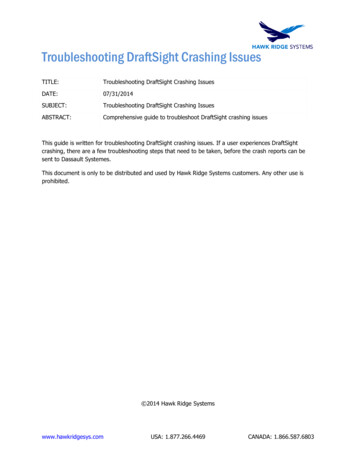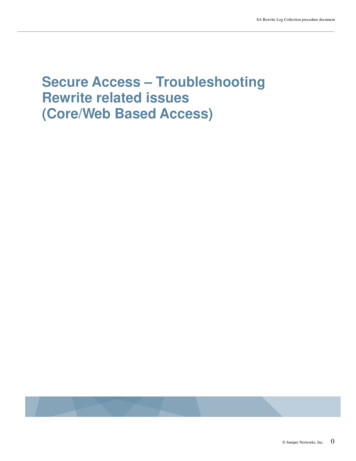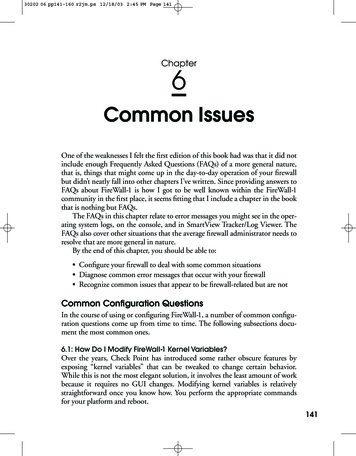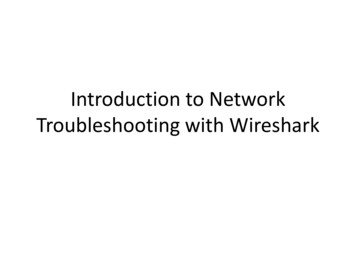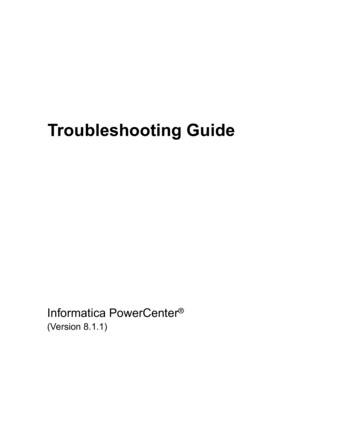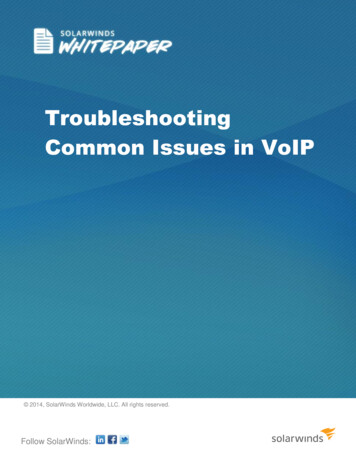
Transcription
TroubleshootingCommon Issues in VoIP 2014, SolarWinds Worldwide, LLC. All rights reserved.Follow SolarWinds:
Voice over Internet Protocol (VoIP)IntroductionVoice over IP, or VoIP, refers to the delivery of voice and multimedia over IP networks. The steps involved inoriginating a VoIP telephone call are signaling and media channel setup, digitization of the analog voice signal,encoding, packetization, and transmission as Internet Protocol (IP) packets over a packet-switched network.On the receiving side, similar steps (usually in the reverse order) such as reception of the IP packets, decodingof the packets and digital-to-analog conversion reproduce the original voice stream.1Since the transmission of the packet occurs through an IP network, the quality of communications is inherentlyless reliable than a circuit switched public telephone network. There is no network mechanism to ensure thatdata packets are not lost and are delivered in sequential order. Essentially, it is a best effort without Quality ofService (QoS) guarantees.Several metrics are available for measuring VoIP call quality. This paper will provide a basic understanding ofVoIP traffic and of the quality metrics used to monitor VoIP calls.VoIP MetricsMaintaining high quality VoIP calls can be difficult as VoIP is more sensitive to network delays and packet losscompared to any other network applications. VoIP quality is measured based on the following metrics: Network Jitter and Delay Packet data Loss Latency Mean Opinion Score (MOS)Network Jitter and DelayReal-time voice communications over the network are sensitive to delay in packet arrival time or packetsarriving out of sequence. Excess jitter results in calls breaking up. Jitter can be reduced to a certain extent byusing jitter buffers. Jitter buffers are small buffers that cache packets and provide them to the receiver insequence and evenly spaced for proper playback. Buffer lengths can be modified, however, if jitter buffer isincreased too much then the call will experience an unacceptable delay. Consequently, a reduction in bufferturns results in less delay but more packet loss. Jitter is measured in milliseconds (ms).Follow SolarWinds:2
Packet data LossPacket loss occurs when one or more packets of data fail to reach their destination. A single packet loss isreferred to as “packet gap”, and series of packet loss is known as” burst”. Packet loss can occur for a variety ofreasons including link failure, high congestion levels, misrouted packets, buffer overflows and a number ofother factors. Packet loss causes interrupted playback and degradation in voice quality. Packet loss can becontrolled using packet loss concealment techniques within the playback codec.LatencyLatency, or lag, is the time delay caused in the transmission of a voice packet. Excess latency results in delayand finally to echo. Latency is measured in milliseconds (ms)Mean Opinion Score (MOS)Mean Opinion Score is a numerical value to indicate the perceived quality of the call from the user’sperspective of the received call after compression, transmission, and decompression. MOS is a calculationbased on the performance of the IP network and is defined in the ITU-T PESQ P.862 standard and isexpressed as a single number in the range of 1 to 5, where 1 is lowest perceived quality and 5 is the highest.Desirability ScaleR-FactorMOS ValueDesirable94 - 804.4 - 4.0Acceptable80 - 704.0 - 3.6Reach Connection70 - 503.6 - 2.6Not50 - 02.6 - 0RecommendedR-FactorThe R-factor is a score that takes into account both user perceptions (User R-factor) and the effect ofequipment impairments (Network R-factor) to arrive at a numeric expression of voice quality. These metrics arecalculated by a formula that balances all equipment impairments and perception factors and is reported as aFollow SolarWinds:3
single number on a per-call basis, typically in the range of 15 to 94.The MOS and R-Factor helps indetermining the QoS. The R-factor is calculated using a basic formula called E-Model as shown below.R-Factor Ro – Is – Id – Ie AR-Factor: Overall network quality rating (ranges between 0 and 100)Ro: Signal to noise ratioIs: Impairments simultaneous to voice signal transmissionId: Impairments delayed after voice signal transmissionIe: Effects of Equipment (MOS is converted to le)A: Advantage factor (attempts to account for caller expectations)Call Detail Records (CDRs)A CDR is a data record that documents the details of a phone call and fall into one of two classifications: thebasic CDR, and the diagnostic CDR or CMR (Call Monitor Records). The basic CDR includes informationabout the call such as originating phone number, receiving phone number, call starting time, call duration,billing details, and other call details. The CMR includes metric information needed for monitoring VoIP callsincluding addresses, status (successful, failed, transferred), number of packets, packet bytes, packet loss, starttime, initial setup duration, duration, current jitter, maximum jitter, MOS, R-factor, QoS for each call, number ofpackets that arrive out of order, detailed analysis for packet loss and delay, gap and burst measurements, andlong-term Call Detail Records trending.Monitoring VoIP PerformanceIn order to properly troubleshoot VoIP call quality, you should have a number of tools at your disposal thatmonitor and measure the critical call quality components. VoIP monitoring typically falls into one of threecategories: Network monitoring tools that monitor VoIP performance based on network performance statistics Protocol analyzers Dedicated VoIP tools Synthetic VoIP traffic generatorsNetwork Monitoring ToolsFollow SolarWinds:4
Network monitoring tools are non-intrusive, or passive, and examine each stream of voice traffic across thenetwork to estimate the MOS score and calculate the R-Factor. The use of network monitoring tools has theadvantage that all calls in the network can be monitored without any additional network overhead. For the ITprofessional, monitoring VoIP using network monitoring tools is essentially just another network task and,therefore, typically the most practical approach.Protocol AnalyzersProtocol analyzers are hardware or software tools that capture and analyze VoIP traffic packets and calculatejitter, and latency directly from the packet stream.Dedicated VoIP ToolsMost dedicated VoIP tools were originally developed for the telecomm industry and are great for testing IPphone and gateway designs but not as good at solving deployment problems within the network.Synthetic VoIP Traffic GeneratorsSynthetic VoIP traffic generators reduce time to the readiness of VoIP services, while assuring they meetquality requirements as perceived by users.Troubleshooting VoIP Quality IssuesQuality VoIP calls require a quality IP network that can deliver voice packets within the minimum requirementsaround jitter, packet loss, and latency. Network monitoring systems and specifically network traffic monitoringsystems can help the IT professional better understand the impact of network performance on VoIP call quality.At a minimum, you need to analyze at the end points (both call origination point and call destination point),however, measuring at additional points within the call path will help further narrow the potential problemareas.Step 1: Check the error/status code to indicated failed calls–see error description. (In case of a fail call go tostep 4)Step 2: Check MOS score. If it’s bad, try to find calls placed at the same time and verify if they MOS wassimilarStep 3: Analyze packet loss, latency or jitter in order to see what could be a potential problem (slow network,unreliable network, overloaded routers or switches)Follow SolarWinds:5
Step 4: If possible do comparison of the calls that were placed between the same locations at the same time toconfirm symptomsStep 5: Look for the related gateways and call managers and their performance status (usually via callconnection topology)Step 6: Try to see call path and all related network element like routers and switches and see theirperformance metrics.Step 7: Verify channel utilization at the time of the call.Step 8: Verify call related end-point devices (soft IP phones, HW phones)Step 9: Establish VoIP synthetic operation between the same locations to prevent the same issue andcontinuously monitor situationBest Practices in VoIP Benchmark your network health before and after your deployment Automate monitoring and measurement of the call quality components and metrics Measure at multiple points to see exactly where call quality drops Upgrade your equipment to support QoS, PoE, layer 3 protocols, and multiple VLANs Determine the proper CODEC based on your WAN and LAN capabilities Monitor your gateways and channel utilization Monitor your call path network devices performance – mainly routers and switches.References1Voice over IP. (2012, June 6). In Wikipedia, The Free Encyclopedia. Retrieved 15:35, June 12, 2012, fromhttp://en.wikipedia.org/w/index.php?title Voice over IP&oldid 4962430Follow SolarWinds:6
Top 5 reasons to Download SolarWinds VoIP & Network Quality Manager(VNQM)1. Analyze Call Detail Records generated by Cisco Call Manager & Avaya Communication Manager2. Automatically determine and deploy IP SLA3. Be notified when key VoIP metrics such as jitter, latency, packet loss, or MOS exceeds thresholds4. Monitor and troubleshoot VoIP call performance for Cisco & Avaya5. Gain detailed visibility into performance of Cisco VoIP gateway and PRI trunk utilizationGet a global snapshot of your IP SLA operations with SolarWinds VNQM!About SolarWindsFollow SolarWinds:7
SolarWinds (NYSE: SWI) provides powerful and affordable IT management softwareto customers worldwide from Fortune 500 enterprises to small businesses. In all ofour market areas, our approach is consistent. We focus exclusively on IT Pros andstrive to eliminate the complexity that they have been forced to accept fromtraditional enterprise software vendors. SolarWinds delivers on this commitment withunexpected simplicity through products that are easy to find, buy, use and maintainwhile providing the power to address any IT management problem on any scale. Oursolutions are rooted in our deep connection to our user base, which interacts in ouronline community, thwack , to solve problems, share technology and best practices,and directly participate in our product development process. Learn more today athttp://www.solarwinds.com.Follow SolarWinds:8
Several metrics are available for measuring VoIP call quality. This paper will provide a basic understanding of VoIP traffic and of the quality metrics used to monitor VoIP calls. VoIP Metrics Maintaining high quality VoIP calls can be difficult as VoIP is more sensitive to network delays and packet loss compared to any other network applications.
